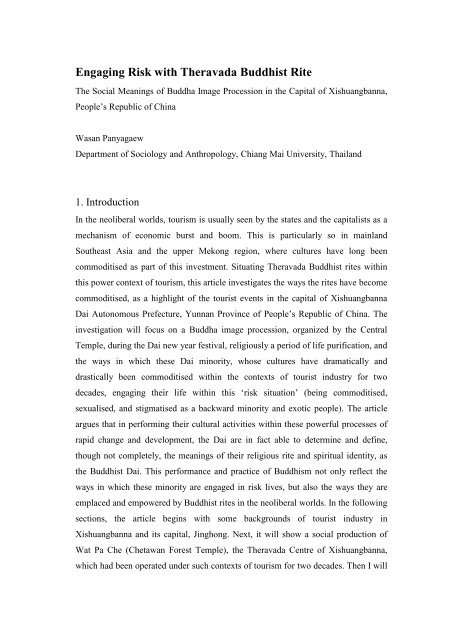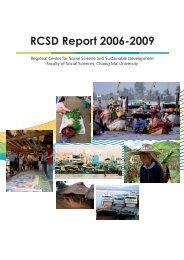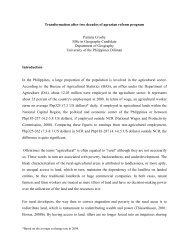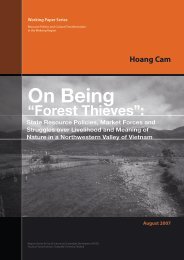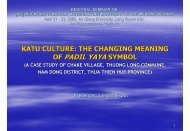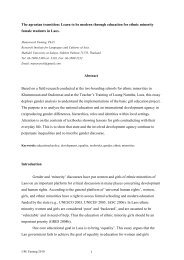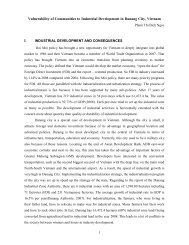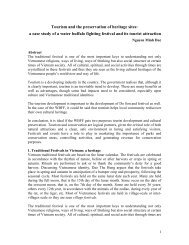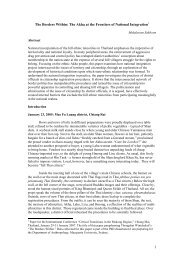An overall view of Theravada Buddhist Revivalism - RCSD
An overall view of Theravada Buddhist Revivalism - RCSD
An overall view of Theravada Buddhist Revivalism - RCSD
- No tags were found...
You also want an ePaper? Increase the reach of your titles
YUMPU automatically turns print PDFs into web optimized ePapers that Google loves.
Engaging Risk with <strong>Theravada</strong> <strong>Buddhist</strong> RiteThe Social Meanings <strong>of</strong> Buddha Image Procession in the Capital <strong>of</strong> Xishuangbanna,People‟s Republic <strong>of</strong> ChinaWasan PanyagaewDepartment <strong>of</strong> Sociology and <strong>An</strong>thropology, Chiang Mai University, Thailand1. IntroductionIn the neoliberal worlds, tourism is usually seen by the states and the capitalists as amechanism <strong>of</strong> economic burst and boom. This is particularly so in mainlandSoutheast Asia and the upper Mekong region, where cultures have long beencommoditised as part <strong>of</strong> this investment. Situating <strong>Theravada</strong> <strong>Buddhist</strong> rites withinthis power context <strong>of</strong> tourism, this article investigates the ways the rites have becomecommoditised, as a highlight <strong>of</strong> the tourist events in the capital <strong>of</strong> XishuangbannaDai Autonomous Prefecture, Yunnan Province <strong>of</strong> People‟s Republic <strong>of</strong> China. Theinvestigation will focus on a Buddha image procession, organized by the CentralTemple, during the Dai new year festival, religiously a period <strong>of</strong> life purification, andthe ways in which these Dai minority, whose cultures have dramatically anddrastically been commoditised within the contexts <strong>of</strong> tourist industry for twodecades, engaging their life within this „risk situation‟ (being commoditised,sexualised, and stigmatised as a backward minority and exotic people). The articleargues that in performing their cultural activities within these powerful processes <strong>of</strong>rapid change and development, the Dai are in fact able to determine and define,though not completely, the meanings <strong>of</strong> their religious rite and spiritual identity, asthe <strong>Buddhist</strong> Dai. This performance and practice <strong>of</strong> Buddhism not only reflect theways in which these minority are engaged in risk lives, but also the ways they areemplaced and empowered by <strong>Buddhist</strong> rites in the neoliberal worlds. In the followingsections, the article begins with some backgrounds <strong>of</strong> tourist industry inXishuangbanna and its capital, Jinghong. Next, it will show a social production <strong>of</strong>Wat Pa Che (Chetawan Forest Temple), the <strong>Theravada</strong> Centre <strong>of</strong> Xishuangbanna,which had been operated under such contexts <strong>of</strong> tourism for two decades. Then I will
the international terminal in Jinghong airport, this capital <strong>of</strong> Xishuangbanna has beenwell connected to the outside world. The numbers <strong>of</strong> tourist in this minorityprefecture have increased dramatically. The modern aviation not only acceleratestravellers‟ mobility, domestic and overseas, into this city, but also shapes and„compresses‟ the locals‟ perception <strong>of</strong> time and space. Paradoxically, according toSandra Hyde, many „local Han‟ in the city explained that the prostitutes came withthe new airport „as if the flights and sex went together‟ (2001: 149).Since the 1980s, Xishuangbanna was initially portrayed by Han writers (Zheng Lanin his publication, for example) as well as by the local government and investors inXishuangbanna tourism (in their tourist campaigns), as „a subtropical paradise‟, andJinghong was transformed into the centre <strong>of</strong> this subtropical region in southwestChina. Ten years after that, a new imageography was constructed through the eroticimages <strong>of</strong> Dai women, adding another aspect to this borderland, as „a site <strong>of</strong> sexualdesire‟ (Evans 2000: 167-170, Hyde 2001, Keyes 1992: 21, 24). This aspect isimplicitly and explicitly represented in tourist advertising, catalogues, hotelpostcards, and banners which are posted in, around the city, and in the tourist spotsaround Xishuangbanna. In the discourse <strong>of</strong> national development and touristindustry, the Dai, in other words, have been presented as uncivilised, backward andundeveloped, and sexualised, symbolically as inferior women in relation to Han atboth societal and everyday levels. The development projects in Xishuangbanna in the1990s have been provocatively interpreted by Hyde as a story <strong>of</strong> how Jinghong“became a city <strong>of</strong> sex tourism”, providing Han Chinese male tourists with a lucrativesex tourist destination (2001: 144). In her study <strong>of</strong> HIV/Aids and migrant prostitutesin Xishuangbanna, Hyde demonstrates that Dai women are now constructed andrepresented as sexual objects in an erotic mythology which is „read‟ by Hanconsumers through a tourist discourse (ibid: 155-161). What the male tourists cometo consume in this city, Hyde maintains, are Dai women, although “the majority <strong>of</strong>prostitutes are not [D]ai but women from Sichuan and Guizhou dressed in [D]aiclothing to attract Han male customers” (ibid: 144).3
Hotel postcard for tourist attractionMoreover, as I have observed, the new campaign and discourse <strong>of</strong> what we mightrefer to as “Sipsong Panna as the little Thailand” is another process that is reconstructingand transforming the image <strong>of</strong> Jinghong city and Xishuangbanna as awhole in the Han tourists‟ imagination. This new project <strong>of</strong> cultural affiliation andhistoric connections between the Dai and the Thai is reflected and manifestedthrough everyday discourses, tourist guide books, TV ads, and the Han tourist‟sconsumption <strong>of</strong> Thailand T-shirts, which are popularly distributed in Jinghong cityand tourist spots around the prefecture. Recently, it was estimated that the population<strong>of</strong> Xishuangbanna was one-third Han, one-third Dai, and one-third other ethnicgroups. According to People’s Daily (14 April 2004), <strong>of</strong> 13 ethnic minority groups inXishuangbanna, the Dai nationality minority accounted for 34 percent <strong>of</strong> the 990,000population in this region. 1 But what is more important than the total populationfigure is where people <strong>of</strong> different kinds have settled. Statistically, in the mid-1990s,for example, <strong>of</strong> the total population <strong>of</strong> Xishuangbanna, which was estimated at about817,000, the numbers <strong>of</strong> registered Han formed about 26 percent, but in JinghongCounty they comprised 34 percent <strong>of</strong> the total population, and 48 percent <strong>of</strong> thewhole population in Jinghong city.Note that these demographic proportion figures do not include the „floatingpopulation.‟ In addition, it was estimated that in 2002 alone there were about 2.5million tourists, domestic and overseas, 2 but most <strong>of</strong> these were Han Chinese, that1 http://english.people.com.cn/200304/14/eng20030414_115125.shtml2 Cited from People’s Daily online.4
came to and through this city. The Han, migrants or not, locals or tourists, in short,are dominant in the commercial zones <strong>of</strong> the city and towns around the region, whilstthe Dai (and other minority groups) have seemingly been constrained or pushed backto live their lives in the villages.People‟s mobility and processes <strong>of</strong> „new connectivity‟, accelerated by the statecampaigns and investments in tourism, as stated earlier, in Jinghong city and inXishuangbanna as a whole have indeed formed a remarkable historical phenomenon.These processes have significantly formed and transformed both peoples and placesin this minority region, resulting in the displacement <strong>of</strong> traditional „Sipsong Panna.‟Yet all places (villages, towns, or cities) are constituted by the inhabitants who livein them (de Certeau 1984, Feld and Basso 1996), and the increased mobility <strong>of</strong>inhabitants (temporary inhabitants and tourists included), both coming in and goingout, has been used to contribute to new forms <strong>of</strong> social space. These spaces in turnprovide a means whereby inhabitants can maintain, interpret, operate, or evenimprovise upon their ordinary practices <strong>of</strong> living in particular „places.‟3. A Social Production <strong>of</strong> <strong>Buddhist</strong> PlaceIn the mid-1980s, the Xishuangbanna <strong>Buddhist</strong> Association, reestablished soon afterthe end <strong>of</strong> Cultural Revolution, constructed its headquarters, aimed to use this <strong>of</strong>ficeto operate its mission. The first headquarters was situated behind Ban Tin Temple(en route to the street <strong>of</strong> Mantin Lu, southern part <strong>of</strong> Jinghong city). TheAssociation‟s main task was then to teach and train all new novices who wererecruited from their communities throughout the countryside <strong>of</strong> Xishuangbanna.Each year, from 1985 to 1990, about 40 to 60 Dai novices throughoutXishuangbanna came to Jinghong city attending orientation programs at the Ban Tinheadquarters. Interestingly, these orientation programs were in practice mainlyconducted by senior monks who were cross-border monks from the Shan state <strong>of</strong>Burma. 3 Basically, what they taught and trained the young novices in this program3 All <strong>of</strong> them later became leading members in the Sangha and since played a crucial role in<strong>Theravada</strong> revivalism in Xishuangbanna, for a decade. Particularly, Tu Luang has continued hispriesthood until today. Since 1993, he has become the Abbot <strong>of</strong> the Central Temple and the director <strong>of</strong>5
were <strong>Buddhist</strong> disciplinary practices, precepts, sutras, Tai script, and Buddha‟steachings. „The loss <strong>of</strong> tradition‟ during the Cultural Revolution meant not onlyshortages <strong>of</strong> monks and their discipline but also a lack <strong>of</strong> Buddha‟s teachings and„local knowledge‟, which can only be accessed by the uses <strong>of</strong> Tai script. Theorientation program run by the Association, in this sense, was therefore a means tobuild and improve the Dai novices <strong>Theravada</strong> disciplines, not to „preserve‟ thistradition as many scholars have misinterpreted. Ultimately, it is at the same time anattempt to develop, standardise, and even modernise <strong>Theravada</strong> Buddhism inXishuangbanna in the new era <strong>of</strong> modern China.Along with the physical expansion <strong>of</strong> Jinghong city and the booming <strong>of</strong> touristindustry in Xishuangbanna, in the late 1980s, the <strong>Buddhist</strong> Association began to lookfor a new location for its permanent headquarters <strong>of</strong>fice. Members <strong>of</strong> the Association(who were mostly old Dai scholars and senior monks) eventually decided to choosethe former site <strong>of</strong> Wat Pa Che (Chetawan Forest Temple), which had been desertedand had become forested for more than 30 years. The reconstruction project <strong>of</strong> WatPa Che, the Central Temple afterwards, began in 1988 and firstly they built theViharn, which was completed about one year after that. At the beginning <strong>of</strong> 1990, the<strong>Buddhist</strong> Association finally relocated its headquarters <strong>of</strong>fice to the Central Temple,which is currently located at the edge <strong>of</strong> the city‟s ring road to the southwest (seeMap <strong>of</strong> Jinghong city).In the early 1990s, although the new Viharn had been built, the construction project<strong>of</strong> the Central Temple still went on. It was not an overnight project as some mayhave thought. There was lots <strong>of</strong> money the Association needed for the construction<strong>of</strong> this new religious centre, so necessary to reform and develop <strong>Theravada</strong>Buddhism in Xishuangbanna. 4 The lately project <strong>of</strong> the Abbot‟s Building, locallycalled Kuti Khruba, was completed in 2002. Recently, in 2008, the Khruba justthe <strong>Buddhist</strong> Association, and in January 2004, he has become the Khruba Muang, the SupremePatriarch <strong>of</strong> Sipsong Panna Sangha.4 The first important move to accomplish this mission was to send a delegation <strong>of</strong> Dai monks andnovices to study abroad in a Thai <strong>Buddhist</strong> monastery school (in 1991). After finishing their <strong>Buddhist</strong>studies the delegation was expected to bring „new knowledge‟ back to their country, and contribute tothe development <strong>of</strong> <strong>Theravada</strong> traditions in Xishuangbanna (see details in Panyagaew 2010).6
knocked down the first-built Viharn, which had been poorly constructed ten yearsago, thus artistically it was considered by him as the religious centre without its prideand identity. His idea was to replace such poorly architectural building with the newwooden Viharn, the typical look <strong>of</strong> the Dai religious site and architecture.<strong>An</strong> investigation on the social production <strong>of</strong> this <strong>Theravada</strong> centre <strong>of</strong> Xishuangbannatoday is indeed interesting and important. Even the decision to select the site madeby member committees in the Association had its symbolical meanings. For this isthe former site <strong>of</strong> Wat Pa Chetawan, one <strong>of</strong> the royal temples in the old ChiangHung, historically located behind the royal park <strong>of</strong> the King <strong>of</strong> Sipsong Panna (whichhas currently become Man Tin Park tourist spot, south <strong>of</strong> Jinghong city). In thissense, the construction and expansion <strong>of</strong> this <strong>Buddhist</strong> place and its territory can bethought <strong>of</strong> as a symbolic manifestation <strong>of</strong> the complex processes <strong>of</strong> <strong>Theravada</strong>revivalism and social risk engagements among the Dai in their displaced homeland.The construction project <strong>of</strong> the Central Temple complex and its territorial expansionowes much to the visits, financial support, and connections with Thai <strong>Buddhist</strong>s inThailand. The visits <strong>of</strong> several Thai donors and visitors, led by Khruba Maha Khuenfrom northern Thailand in the late 1980s, and particularly when the SupremePatriarch <strong>of</strong> the Thai Sangha made his journey to the Central Temple in 1991, weresymbolical and fundamental for the establishment <strong>of</strong> the Temple complex, the<strong>Theravada</strong> Centre in Xishuangbanna today. These forms <strong>of</strong> transnational mobilityand connectivity therefore do play crucial roles in the reformation <strong>of</strong> Dai <strong>Theravada</strong>Buddhism in Xishuangbanna. The construction project is thus manifested that, withinthe context <strong>of</strong> expansion <strong>of</strong> Jinghong city and the rapid transformation inXishuangbanna, various agencies and flows <strong>of</strong> people and capital from differentdirections that have come to get involved in this social production <strong>of</strong> Dai <strong>Buddhist</strong>place.The year 1993 was a turning point for the Central Temple. In that year, Pii Nhan, thefirst abbot <strong>of</strong> the Temple, decided to disrobe and became a news-reporter in a staterunlocal Dai newspaper. Following the first abbot‟s resignation, in that same year <strong>of</strong>7
1993, the Association invited Tu Long, who would later become the Khruba Muang<strong>of</strong> Sipsong Panna, to take up higher positions in the highest administrative unit <strong>of</strong> theXishuangbanna Sangha.Soon after he had been appointed as the Abbot and the director <strong>of</strong> the <strong>Buddhist</strong>Association, Tu Long (Khruba afterwards) began to run his mission, to establish themonastery school at the Central Temple. He made trips to contact Chinese temples inother big cities and particularly to visit leading monks and temples in Thailand,telling them <strong>of</strong> the holy project <strong>of</strong> developing a <strong>Buddhist</strong> monastic school in thecapital <strong>of</strong> Xishuangbanna. Not surprisingly, in accomplishing this mission, Khrubasometimes made use <strong>of</strong> his „old networks‟ developed when he had been a crossborderstudent monk in Chiang Mai, northern Thailand, for three years.The most important support from Thailand that marked the establishment <strong>of</strong> theCentral Temple monastery school took place in 1993, when the then Abbot <strong>of</strong> WatPak Nam, in Bangkok, brought Thai capital <strong>of</strong> about 2,000,000 THB (50,000 US$),to „Sipsong Panna‟, to support the construction <strong>of</strong> the school building. Theconstruction, according to information inscribed on the school‟s banner, als<strong>of</strong>inancially supported by the <strong>Buddhist</strong> Association, cost about 500,000 RMB (62,500US$). This project was completed in 1994 and the Central Temple‟s <strong>Buddhist</strong>monastery school formally opened its first class in 1995 (one year earlier the CentralTemple had opened a class for 24 student novices).The honorary visit <strong>of</strong> a member <strong>of</strong> the Thai royal family, the Princess Maha ChakriSirindhorn in that same year in March 1995 was indeed symbolically important asKeyes (2000) also showed for her visit to Laos in March 1990. The Thai princessplanted a Bodhi tree within the Central Temple complex on the southwest, markingthe Thai-Dai relationships <strong>of</strong> these modern days in this sacred place (see Map <strong>of</strong> theTemple Complex).In the mid-1990s, there were then the Viharn, monk‟s kuti (huts), the school building(or Hong Hen), and a kitchen hall (or Hong Gang) in this religious complex. The8
Temple complex however still needed to be developed further. The most importantbuilding in this temple, the Bosod, had not yet been built. It was not until 1997 thatthe construction <strong>of</strong> the Bosod began. This was hugely supported financially by theThai King and His Majesty‟s family members, according to Khruba.In October 1998, the Princess Kanlayaniwatthana, the Thai King‟s older sister, madea royal visit to the Central Temple and presented <strong>of</strong>ferings and a donation for theconstruction <strong>of</strong> the Bosod. On this visit, the Thai Princess led the Dai in conducting asacred ritual to enshrine „sacred objects‟ underneath the site <strong>of</strong> the Bosod. 5 Later theconstruction was completed and they celebrated „the new Bosod‟ that same year.Since then the Central Temple has become the real religious centre <strong>of</strong> <strong>Theravada</strong><strong>Buddhist</strong>s in Xishuangbanna. The construction and expansion <strong>of</strong> the Central Templecomplex and its territory still continued, however. This time the project was initiatedby the Abbot himself. Khruba‟s plan was to construct a new Abbot‟s Building (KutiKhruba), designed for accommodating guests and visitors to the Central Temple,showing the greatness <strong>of</strong> Tai <strong>Buddhist</strong> art and architecture.“It is a construction we built for the next generation”, Khruba told me.To accomplish this, the Central Temple first had to buy land, adjacent to its formercompound on the east. The construction <strong>of</strong> the new Abbot‟s Building, therefore,simultaneously expanded the Central Temple territory, turning that formerly forestedland into a <strong>Buddhist</strong> place within Jinghong city. The construction was completed andcelebrated in 2002. Since then, it is not only local <strong>Buddhist</strong>s, both Dai and non-Dai,particularly those who reside in the countryside, who regularly make theirpilgrimages to visit the Khruba and this „new‟ <strong>Theravada</strong> centre <strong>of</strong> Xishuangbanna,but also tourists and visitors, both domestic and overseas.The construction and expansion <strong>of</strong> this religious site and Dai <strong>Buddhist</strong> space in asense ironically reflected the dual processes <strong>of</strong> both the „modern development‟ <strong>of</strong>5 The Princess Kanlayaniwatthana had first visited Jinghong in late 1985.9
<strong>Theravada</strong> Buddhism and the tourism in Xishuangbanna which dramatically began inthe early 1990s, as discussed earlier. Such processes are, therefore, complex andcannot be interpreted in black-and-white terms <strong>of</strong> domination and resistance.Map <strong>of</strong> The Central Temple ComplexIn 1966, Michael Moerman published his seminal work, objecting to the oncepowerful model put forward by John Embree (1950), in the early 1950s, whichportrayed Thai village society as „loosely structured.‟ Throughout this remarkablework, Moerman described and discussed through examples <strong>of</strong> Thai-Lue <strong>Buddhist</strong>s‟everyday practices and regular activities at and through the village temple, how,ultimately speaking, at least in the Thai-Lue village <strong>of</strong> Ban Ping in Chiang Kham,whose ancestors had been resettled from Sipsong Panna in the mid 19 th century, innorthern Thailand he studied, the village temple was the centre <strong>of</strong> this supposedly10
„loosely structured‟ society. In other words, in that Lue community, it was the templethat structured and regulated everyday activities and the <strong>Buddhist</strong> disciplinarypractices <strong>of</strong> the members <strong>of</strong> „village society‟ and also in many ways the ways thosevillagers communicated and associated with „outsiders‟ (e.g. Thai <strong>of</strong>ficials and„social developers‟), through their <strong>Buddhist</strong> centre-temple‟s festivities, ceremonies,and ritual conducts.Although the social productions <strong>of</strong> Ban Ping‟s Temple and the Central Templeoperated in different times, spaces, and places (while the setting <strong>of</strong> the former is asociety <strong>of</strong> external exiles, the Lue who become the Thai-Lue, in northern Thailand inthe 1960s, the setting <strong>of</strong> the latter is a society <strong>of</strong> internal exiles, the Lue who becomethe Dai minority nationality, in modern China after the end <strong>of</strong> the CulturalRevolution), what this <strong>Theravada</strong> centre <strong>of</strong> Xishuangbanna has tried to do (or to„say‟ to „outsiders‟), since its early establishment, has been very similar to whatMoerman described for the Ban Ping temple as regards its „village society‟, I argue.In other words, the Central Temple is in a sense the centralised hub <strong>of</strong> Dai culturalnetworks <strong>of</strong> Xishuangbanna in this regional age. <strong>An</strong>d its mission, to reform anddevelop <strong>Theravada</strong> traditions, can be seen as the way in which it has attempted toreform and restructure Dai culture and society.This process <strong>of</strong> religious revivalism in Xishuangbanna however owes very much tothe new reforms in China, in 1978, and the regional trade and development campaigncooperatively boosted by the four nation-states <strong>of</strong> Burma, Laos, Thailand, and Chinaparticularly since the early 1990s, which in turn intensified the flows and theinterconnectedness <strong>of</strong> people, things, and capitals in these historic frontiers. Asshown above, the Central Temple complex, in this sense, is the product <strong>of</strong> thesetrans-local and transnational processes. Moreover, this social production <strong>of</strong> this<strong>Buddhist</strong> place had taken place for over a decade, historically, and specifically. It isultimately a product <strong>of</strong> the duo-tracks <strong>of</strong> cross-border mobility and connectivity inthe borderlands <strong>of</strong> the upper Mekong today.11
For two decades, since 1989, Khruba has devoted himself to re-establishing theXishuangbanna Sangha, developing Wat Pa Che as the centre <strong>of</strong> XishuangbannaBuddhism, particularly through its <strong>Buddhist</strong> studies program. Though, in 2008 themonastery school was relocated to the new Central Temple, which was just firstopened for the tourists to visit in November 2007. This new Central Temple,idealised by the tourist company as „Southern Buddhism Cultural Center,‟ a newpilgrimage site if you like, locally called „Wat Luang Muang Lue,‟ is situated to thesouth, outside the city ring-road about a few kilometres.In January 2004, (my) Khruba became the Khruba Muang (Supreme Patriarch) <strong>of</strong>Sipsong Panna. As I see it, this religious promotion marked a new era for <strong>Theravada</strong>Buddhism in Xishuangbanna in the post Socialist regime <strong>of</strong> modern China. It was notonly, modern Dai music that was initiated by the Central Temple (see Davis 2005and Wasan 2008) led by the Khruba and his fellows, most <strong>of</strong> them were formercross-border monks who had been to study in the northern Thai <strong>Buddhist</strong>monasteries (see Panyagaew 2010), but also modern <strong>Buddhist</strong> study program andeducational tools, such as VCDs, books and cassette tapes, produced to increaseaccess for ordinary people to Tai script and local knowledge and <strong>Buddhist</strong> legends.<strong>An</strong>d most significantly, the fundamental mission <strong>of</strong> the Central Temple is tomaintain and to promote religious rites and cultural activities, politically andspiritually, for all <strong>Buddhist</strong>s <strong>of</strong> the Tai world. We will explore a partial scenario <strong>of</strong>this mission, through Buddha image procession, organised by the Central Temple, inJinghong city during the three day Dai New Year Festival, the spotlight <strong>of</strong>Xishuangbanna Tourism today.4. Engaging Risk with <strong>Theravada</strong> <strong>Buddhist</strong> RiteThe sixth month, called Duen Hok, in Xishuangbanna has been well known andrecognised as the Dai New Year and „Water Splashing Festival‟ for over threedecades. This month, <strong>Buddhist</strong> Festivals, locally called Poi!, take place throughoutthe region, in the city, towns and the countryside. It is the sixth month, according totheir calendar, but the Lue <strong>of</strong> the Dai <strong>of</strong> Xishuangbanna, like other Tai peoples (Thaiincluded) celebrate their traditional New Year Festival at this time. As discussed by12
Sommai and Dor َ e (1992: 175), unlike the other annual festivals which are linked tothe lunar calendar, the Tai New Year is fixed by astrological calculations. Accordingto Richard Davis, in the case <strong>of</strong> northern Thailand, the Tai “have considered the yearto end on the day on which the sun shifts from the sign <strong>of</strong> Pisces to the sign <strong>of</strong> Aries.This occurs on April 12, 13, or 14” (1984: 99). The New Year in mid-April alsomeans to them „the approach <strong>of</strong> the first rain.‟ The celebration <strong>of</strong> the New YearFestival among the Tais is therefore in part related to the agricultural cycle.Traditionally, the New Year Festival in northern Thailand consisted <strong>of</strong> six principaldays: wan sangkhan laung, the day on which Lady Sangkhan passes by; wan nao, theday <strong>of</strong> putrefaction; wan phaya wan, the Prince day; wan pak pi, the Day <strong>of</strong> theYear‟s Mouth; wan pak duen, the day <strong>of</strong> the Month‟s Mouth; and wan pak wan, theDay <strong>of</strong> the Day‟s Mouth” (Sommai and Dor َ e 1992: 177, Davis 1984: 99-147). Thissequence <strong>of</strong> the Festival is interpreted by Davis as following the pattern <strong>of</strong> a rite depassage (1984: 100). The Tai New Year Festival, he summarises, “is a time <strong>of</strong>bawdiness, <strong>of</strong> relaxation <strong>of</strong> the rules governing conduct between the sexes, <strong>of</strong>heightened sexual contact between young men and women, and <strong>of</strong> general merrymaking”(ibid).For decades, the time for celebrating the „traditional Tai New Year Festival‟ whetherin Thailand or Xishuangbanna, has been fixed in accordance with the Westerncalendar, from 13-15 April each year. In the case <strong>of</strong> present Thailand, in 1889, theSiamese government declared April 1 as New Year Day. This was changed toJanuary 1940 one year after the country‟s name had been changed to be „Thailand‟,in accordance to the Western calendar. These changes however have been ignored bypeople in the countryside, the northern Thai in particular, „to whom New Year meansmid-April and the approach <strong>of</strong> the first rain‟ (Davis 1984: 99). Since the early 1940s,13 April has been made a public holiday. <strong>An</strong>d, in 1990 the Thai government<strong>of</strong>ficially designated „Songkarn eve‟, April 12, 13, and 14 as a public holiday. Thisdecision can be considered as „a concession to the tradition‟ (Sommai and Dor َ e1992: 176). Later these holidays are rescheduled again to be April 13, 14, and 15.13
During the New Year Festival that year, the Chiang Mai Municipality also organised„a grand procession carrying Buddha images on a long route through the city‟ (ibid:180). The procession began in afternoon, walking from the east to the west alongCharoen Muang Road, crossing the Mae Ping River on Nawarat Bridge, through theinner city. It ends at Wat Pra Singh, where the Buddha image „was set on atemporary altar outdoors, so that people could come to‟ conduct Buddha imagebathing ceremony for three days (Sommai and Dores 1992: 180-181). Promoted andmanipulated by the state and tourist industries, the „traditional New Year‟ celebrationin Thailand has become the major event <strong>of</strong> the year. As a result, Chiang Mai city hasparticularly become „the centre <strong>of</strong> Water Splashing Carnival‟ (which lasts for 3 days)for over a decade.In Xishuangbanna, it was precisely the state, through the local government and thepromotion <strong>of</strong> tourist industry in this region that organised, and in many waysinvented, various kinds <strong>of</strong> „command performances and traditions‟ which producedand shaped the Dai New Year Festival as it is today. The date <strong>of</strong> this „Dai New YearFestival‟ (13-15 April), for example, was determined by the local government, whichhad launched its development campaign on tourism in the early 1990s. In someyears, the traditional New Year day when the Dai (who still strictly use their Taicalendrical system) conducted their <strong>Buddhist</strong> ceremonies (at the temples) andcelebrations therefore probably did not exactly correspond to the new day fixed bythe local government at all. This changing time system, similarly to the Khon Muangin northern Thailand, was seemingly not a serious problem, however. As a result, thecelebration <strong>of</strong> the Dai New Year Festival took place at least twice, at different times,both in the city (organised by the local government) and in certain towns or villagesin the countryside. „Dai New Year Festivals‟ in Xishuangbanna were usually heldfrom the second week <strong>of</strong> April to the end <strong>of</strong> the month.As I have observed, since 2002, and was also told by a Dai friend and the secretary<strong>of</strong> the Xishuangbanna <strong>Buddhist</strong> Association, each year the numbers <strong>of</strong> Dai villagerwho travelled to join the celebration <strong>of</strong> the New Year Festival organised by the localgovernment in Jinghong city have dramatically increased. This was particularly so14
Map <strong>of</strong> Jinghong CityIndeed, the celebration <strong>of</strong> Dai New Year Festival, particularly the „Water SplashingCarnival‟, held on the last day <strong>of</strong> the three-day Dai New Year Festival, in Jinghongcity has been highly popular among tourists nationally and internationally, Hantourists in particular. <strong>An</strong>ouska Komlosy who observed and well described, in herarticle, the procession <strong>of</strong> Buddha images and the „water splashing carnival‟ inJinghong city, argues that the procession through the city is precisely a stage onwhich „Dai display their presence.‟ But this minority demonstration “is followed byrowdy Water Splashing celebrations, during which the same street that saw theserenity <strong>of</strong> a Dai way <strong>of</strong> being become awash with groups <strong>of</strong> battling skirmishers <strong>of</strong>all nationalities” (2004: 367-368). The procession and the „water splashing carnival‟,as she interpreted, thus recently “have become a way to distinguish those from[Xishuangbanna] from outsiders, blurring so called „ethnic boundaries‟” (ibid: 367),though temporarily, between „native Dai‟ and „local Han.‟16
However, we should be aware that this Dai New Year Fair at the Central Temple hasonly recently been „invented‟ and become taken for granted. Also one should notconfuse the New Year carnival parade organised by the local government that takesplace on the first day <strong>of</strong> the Dai New Year Festival (13 April), with this Buddhaimage procession, initially organised by the Central Temple, which is held on thesecond day <strong>of</strong> the Festival (14 April). Most tourist spectators pay more attention tothe former event, and the „one day Water Splashing‟ which the local government hasorganised to be held on the last day <strong>of</strong> the Festival (15 April), but it is really theprocession which most effectively produces significant meanings for the Dai andother inhabitants <strong>of</strong> the city who are impressed by it, in particular the local Han;meanings which mark out their cultural spaces and define their social identities. Inthis sense, the Dai New Year Festival promoted by the state, via the XishuangbannaTourism <strong>of</strong> Authority, as a means to boost the Xishuangbanna tourist economy, Iargue, is eventually appropriated by the Dai minority, led by their religious centre,who use it as a new spatial setting to express their cultural identity and <strong>Theravada</strong>traditions, simultaneously inscribing their „sense <strong>of</strong> belonging‟, by the walking intothe city, manifested through the Buddha image procession. In other words, the „NewYear Festival‟ is a new social space that has opened for the Dai in which they can beinvolved, maintain and „develop‟ their sense <strong>of</strong> place and their „originality‟:engaging their risk with <strong>Buddhist</strong> rite, in the rapid changes and culturaltransformation <strong>of</strong> „Sipsong Panna‟ – the Lue motherland for centuries.5. ReferenceDavis, Richard1984 Muang Metaphysics, Bangkok: Pandora.Davis, Sara L.2005 Song and Silence: Ethnic Revival on China's Southwest Borders, New York:Columbia University Press.de Certeau, Michel1984 The practice <strong>of</strong> everyday life, translated by Steven Rendall, Berkeley:University Of California Press.17
Evans, Grant2000 “Transformation <strong>of</strong> Jinghong, Xishuangbanna, PRC” Where China meetsSoutheast Asia, edited by Grant Evans, Christopher Hutton, and Kuah KhunEng: 162-182.Feld, Steven and Keith H. Basso (edited)1996 Senses <strong>of</strong> place, Santa Fe, N.M.: School <strong>of</strong> American Research Press.Hyde, Sandra2001 “Sex Tourism Practices on the Periphery: Eroticizing Ethnicity andPathologizing Sex on the Lancang”, in China Urban, edited by Nancy N.Cohen, Constance D. Clark, Suzanne Z. Gottschang, and Lyn Jeffery,Durham & London: Duke University Press.Keyes, Charles F.1992 “Who are the Lue Revisited? Ethnic Identity in Laos, Thailand, and China”,Working Paper, Centre for International Studies. Cambridge: MIT.Komlosy, <strong>An</strong>ouska2004 “Procession and Water Splashing: Expressions <strong>of</strong> Localtiy and Nationalityduring Dai New Year in Xishuangbanna”, The Journal <strong>of</strong> the Royal<strong>An</strong>thropological Institute, Vol. 10, No. 2: 351-373.Li, Jing2004 “Tourism Enterprises, the State, and the Construction <strong>of</strong> Multiple DaiCultures in Contemporary Xishuang Banna, China”, Asia Pacific Journal <strong>of</strong>Tourism Research, Vol. 9, No. 4: 315-330.Moerman, Michael1966 “Ban Ping‟s Temple: The Centre <strong>of</strong> a „Loosely Structured‟ Society”,Berkeley: Center for Southeast Asia Studies, Institute <strong>of</strong> InternationalStudies, University <strong>of</strong> California, Reprinted No. 213.Panyagaew, Wasan2008 "Moving Dai: The Stories <strong>of</strong> A Minority Band from the Upper Mekong" inChallenging The Limits: Indigenous Peoples <strong>of</strong> the Mekong Region, edited byPrasit Leepreecha, Don McCaskill, and Kwanchewan Buadaeng, MekongPress, 2008.2010 “Cross-border journeys and minority monks: the making <strong>of</strong> <strong>Buddhist</strong> place insouthwest China”, Asian Ethnicity, Vol. 11, No. 1 (forthcoming).Sommai Premchit and Amphay Dor َ e1992 The Lan Na Twelve-Month Traditions, Chiang Mai: So Sap Kan Pim.18


